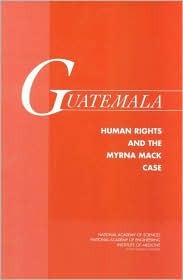

 |

|

The average rating for Guatemala based on 2 reviews is 3 stars.
Review # 1 was written on 2013-09-04 00:00:00 Felice Marcos Felice MarcosStill in the throes of my anthropology [mental] feeding fest, and on top of my recent post on the dilemma of international justice, this post is very timely. I just finished reading Sanford’s book this morning. I’d actually used her Ph.D. dissertation as a source when I wrote my Master’s thesis on postconflict life in Rwanda and Guatemala. It was very cool to meet her at the 2005 AAA’s in DC and to get a copy of her book. Unfortunately, I didn’t have the book before her talk, so I couldn’t get it autographed (I’m an anthro groupie). Sanford’s book is a must read for a slew of audiences: anthropologist, Latin Americanist, human rights worker, international justice specialist, postconflict specialist, and the genearl public. There may be a few groups I left off, but that’s purely unintentional. Sandord has done what so few anthropologists have done, write an accessible book. I read every word and took my time working through her narrative. In some anthro texts, I glance from paragraph to paragraph, looking for little gems amongst the rough. With hers, I took something from almost every sentence. Kudos to you, Victoria! As for the content, she’s covering her work in Guatemala at the tail end of the civil war and in the postconflict transition. She’s focused her story from the ground-up, building collections of testimony from Maya who survived La Violencia, the local name given for the 36+ year civil war in Guatemala. Her field techniques should be mandatory reading material for future anthropologists and all NGOs that do field work. She takes these testimonies to build a strong case against the Guatemalan military and state in its execution of genocide and state-sponsored terror throughout the rural areas of the country. She devotes her last last chapter to extrapolating her data into an analysis of postconflict justice and peace. When discussing amnesty and impunity, she notes that amnesty is simply a retelling of the national narrative during the violence (Sanford 2003:252). In my own words, it’s like the state saying during the violence that “We are right” and afterwards, amnesty is confirming that statement with “We were right.” Her analysis also focuses on how to talk about violence, trying to avoid the traditional Western legal notion of discrete, time-disconnected events. For example, when talking about the massacre in Acul (in Ixil), she noted how the official human rights ombudsman cut off massacre survivor testimony that sought to describe how the violence began, the massacre itself, and the post-massacre continued violence (cultural, mental, and physical). Sanford (2003:258) writes “Limiting data collection to only the massacre provides no insigh to undersanding La Violencia.” Speaking of trials, she illustrates the importance of going after low-level “fish” in addition to the intellectual authors of state violence. She refers to lateral (or what I call local) impunity, whereby the state or its army has been removed from some communities, the local military commissioners are often still in place and still continuing their reigns of terror. “While army officials fear they may be tried for genocide, military commissioners now know they can be tried an convicted for murder and that the army will do nothing to stop the convictions” (Sanford 2003: 269-270). When discussing truth commissions and exchanges of truth for amnesty, in South Africa (Sanford 2003: 259), she explains that such public testimonies often foreground the individual perpetrator but background the state apparatus. We see an individual, not a concrete system of violence. Amnesty precludes state accountability. She paraphrases Spanish prosecutor Baltasar Garzon (who charged Pinochet) who believed “it is only after justice and punishment that forgiveness can be considered” (Sanford 2003:261). Speaking back to her work, I’d like to have seen more discussion of postconflict life, in regards to vigilante justice (a la Godoy’s work) and when individuals use the justice and reconciliation process to settle old scores unrelated to the violence. These are small things to flesh out this outstanding work that Victoria Sanford has produce. |
Review # 2 was written on 2016-07-14 00:00:00 Teresa Fajardo Teresa FajardoIn this excellent ethnography, Sanford centralizes the agency of her interlocutors and emphasizes the importance of their testimony in revealing truth and seeking justice after state-sponsored genocide. The theory with which Sanford engages reminds us that the subversion of state narratives and power--the citizenry holding the state accountable versus the state exerting control over its citizenry with unchecked power--is essential to the maintenance of democracy and the rule of law. |
CAN'T FIND WHAT YOU'RE LOOKING FOR? CLICK HERE!!!